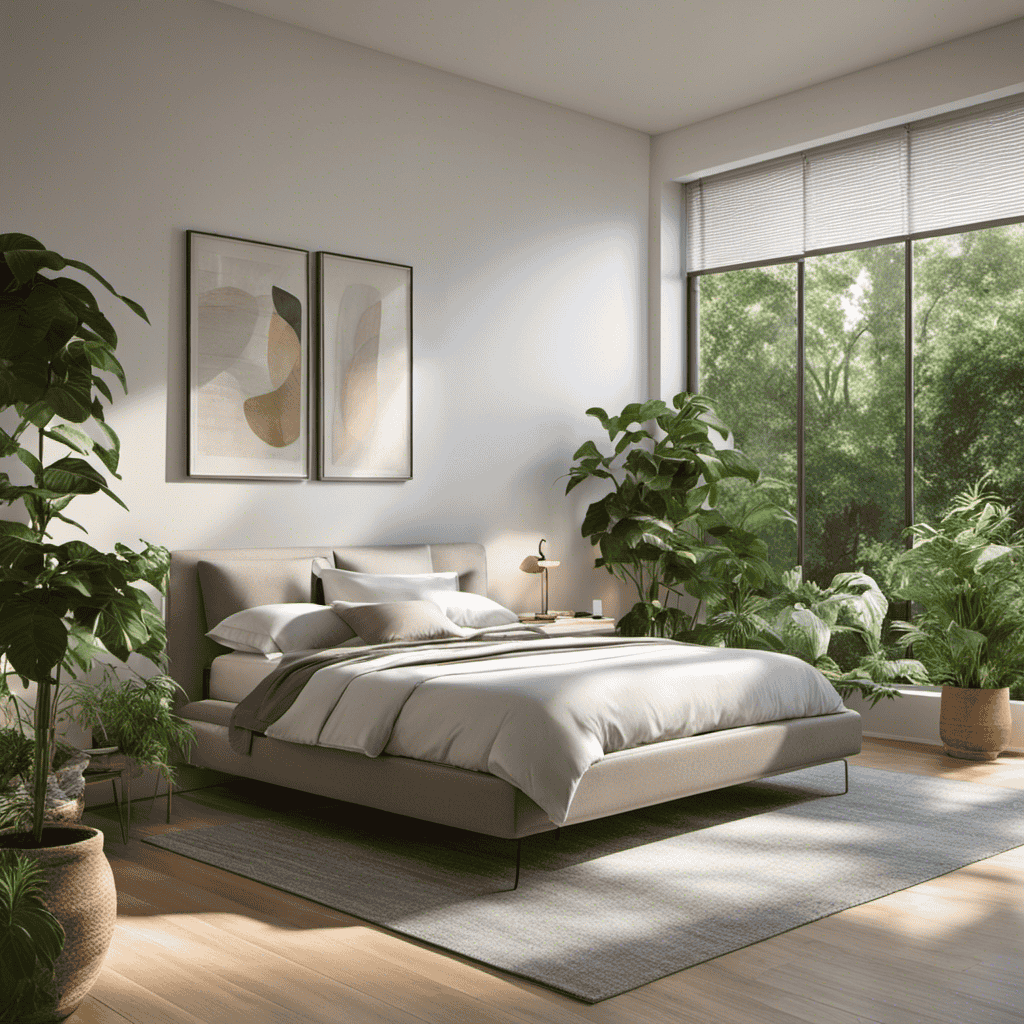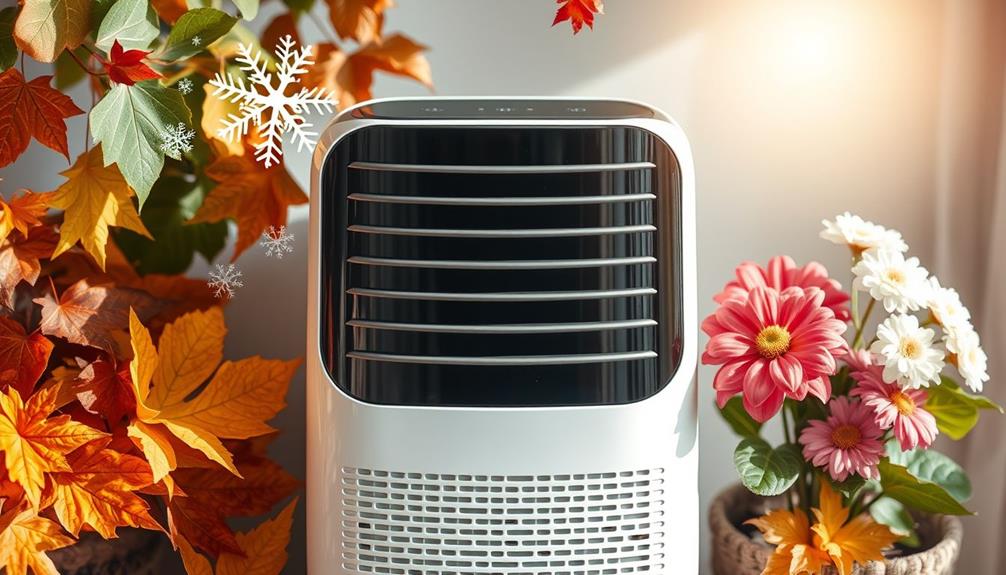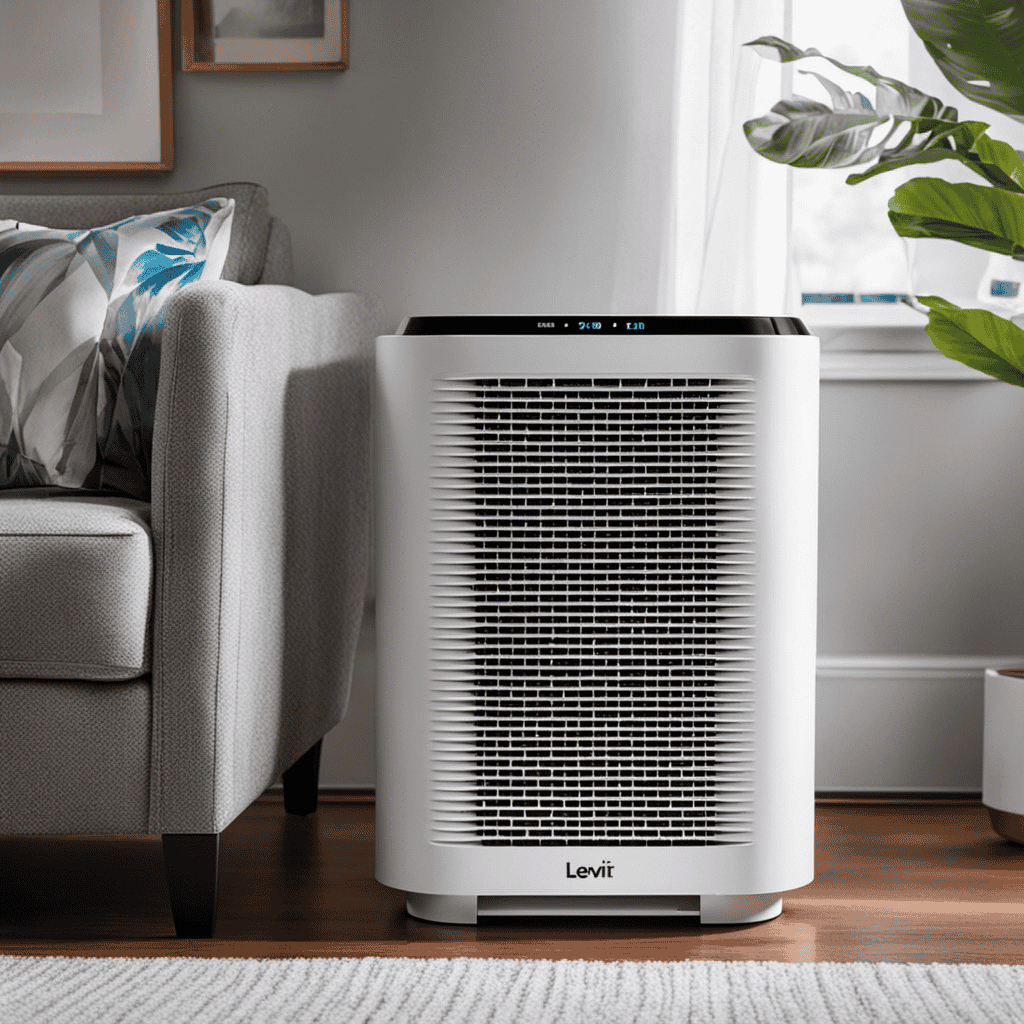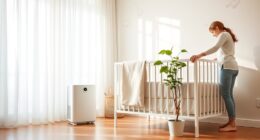I have always questioned whether my Levoit air purifier is effectively doing its job. In a world with high levels of pollutants in the air, it is essential to have a trustworthy device.
Did you know that indoor air can be up to five times more polluted than outdoor air? In this article, I’ll guide you through the process of determining if your Levoit air purifier is effectively improving your air quality.
From checking the filter replacement indicator to evaluating dust and allergen removal, we’ll cover all the essential aspects.
Key Takeaways
- The Air Quality Index (AQI) is a numerical scale that measures the quality of the air, taking into account various pollutants.
- The filter replacement indicator alerts you when it’s time to replace the filter, ensuring optimal performance of the air purifier.
- The noise level displayed on the control panel allows you to monitor the intensity of the sound produced by the air purifier.
- Levoit air purifiers effectively reduce odors and remove dust and allergens, improving air freshness and alleviating allergy symptoms.
Understanding the Air Quality Index (AQI
If you’re unsure if your Levoit air purifier is working, understanding the Air Quality Index (AQI) can help you determine its effectiveness.
The AQI is a numerical scale that measures the quality of the air we breathe. It provides information about the level of air pollution and its potential health effects.
By familiarizing yourself with the AQI, you can gain insight into the air quality in your home and assess whether your air purifier is doing its job.
The AQI takes into account various pollutants such as particulate matter, ozone, carbon monoxide, and sulfur dioxide. It provides a clear indication of the air quality, ranging from good to hazardous.
Monitoring the AQI regularly can help you maintain a healthy indoor environment and ensure that your Levoit air purifier is effectively improving the air quality in your home.
Checking the Filter Replacement Indicator
To check if the filter replacement indicator is working on your Levoit air purifier, look for a light or notification that indicates when the filter needs to be changed.
The filter replacement indicator is designed to help you maintain the optimal performance of your air purifier by alerting you when it’s time to replace the filter. It is an essential feature that ensures you always have clean and fresh air in your space.
To check if the indicator is working, first, ensure that the air purifier is turned on and functioning properly. Then, refer to the user manual to locate the filter replacement indicator and understand its specific indications.
If you are experiencing any issues with the filter replacement indicator, such as it not turning on or not providing accurate notifications, try troubleshooting common issues like resetting the indicator, replacing the batteries if applicable, or contacting Levoit customer support for further assistance.
Regularly checking the filter lifespan and replacing the filter when needed is crucial for maintaining the efficiency and longevity of your Levoit air purifier.
Monitoring the Noise Level
You can easily monitor the noise level of your Levoit air purifier by checking the decibel level displayed on the control panel. This feature allows you to assess the amount of noise produced by the air purifier while it is operating.
The decibel level provides an objective measurement of the sound intensity, giving you an indication of how loud or quiet the purifier is.
Additionally, the control panel also allows you to check the fan speed of the device. This feature enables you to adjust the speed of the fan according to your preference and the specific needs of your environment.
Moreover, the Levoit air purifiers come with specifications for measuring the room coverage. This information helps you determine the optimal placement of the purifier for maximum effectiveness in purifying the air in your room.
Assessing the Odor Reduction
The Levoit air purifier effectively reduces odors in your room, creating a fresher and more pleasant environment. When assessing the effectiveness of the purifier in odor reduction, it is important to compare different models.
To help you make an informed decision, I have created a table below that highlights the key features of three popular Levoit air purifiers: the LV-H132, LV-PUR131, and LV-H134. By comparing the specifications such as coverage area, filter type, and noise level, you can determine which model is best suited for your needs. This table will assist you in evaluating the odor reduction capabilities of each model, allowing you to select the one that aligns with your preferences.
Now, let’s move on to evaluating the dust and allergen removal provided by the Levoit air purifiers.
Evaluating the Dust and Allergen Removal
When it comes to evaluating the effectiveness of an air purifier, there are several key points to consider.
Firstly, visible dust reduction is an important indicator of the purifier’s ability to capture and remove airborne particles.
Secondly, allergy symptom improvement is another key factor to assess, as a good air purifier should provide relief for those suffering from allergies.
Lastly, air quality measurements can provide concrete data on the overall effectiveness of the purifier, allowing us to track and monitor any improvements in the indoor air quality over time.
Visible Dust Reduction
I can see less dust in the air since using my Levoit air purifier. It’s amazing how much cleaner and fresher the air feels in my home. The cleaning effectiveness of this purifier is truly impressive.
Here are three ways I can tell that my Levoit air purifier is reducing air pollution:
-
Reduced Dust Build-Up: Before using the purifier, I would constantly have to dust my furniture and surfaces. Now, I can go longer periods without noticing a significant accumulation of dust.
-
Fresher Odor: The purifier eliminates odors caused by pollutants in the air, leaving a clean and fresh scent in my home.
-
Improved Allergy Symptoms: Since using the purifier, my allergy symptoms have significantly reduced. I no longer suffer from constant sneezing, itchy eyes, and congestion.
Overall, the Levoit air purifier has been a game-changer for me. It not only improves the cleanliness of my home but also enhances the quality of the air I breathe.
Allergy Symptom Improvement
Since using my Levoit air purifier, my allergy symptoms have significantly reduced. I have experienced a noticeable improvement in my respiratory health. The effectiveness of the air purifier in removing allergens and pollutants from the air has made a significant difference in my daily life. I no longer wake up with a stuffy nose or itchy eyes. To illustrate the impact of the air purifier, here is a table showcasing the before and after comparison of my allergy symptoms:
| Allergy Symptoms | Before Air Purifier | After Air Purifier |
|---|---|---|
| Stuffy Nose | High | Low |
| Itchy Eyes | High | Low |
| Sneezing | High | Low |
| Congestion | High | Low |
| Coughing | High | Low |
As you can see, the air purifier has significantly improved my allergy symptoms, leading to better respiratory health. With my allergies under control, I can now focus on other aspects of maintaining a healthy indoor environment.
This improvement in my respiratory health prompted me to assess the air quality in my home more objectively, which I will discuss in the next section: ‘Air Quality Measurements’.
Air Quality Measurements
To accurately measure the air quality in my home, I decided to use a digital air quality monitor. These monitors are equipped with advanced air quality sensors that can detect various pollutants and provide real-time readings. Here are three reasons why using a digital air quality monitor is beneficial:
-
Accuracy: Digital air quality monitors use sophisticated sensors to measure the levels of pollutants in the air, ensuring accurate readings. This helps me understand the true state of indoor air pollution and take appropriate actions to improve it.
-
Real-time monitoring: With a digital air quality monitor, I can monitor the air quality in my home in real-time. This allows me to identify any sudden changes or spikes in pollutants and take immediate steps to address them.
-
Data tracking: These monitors often come with built-in data tracking features that allow me to record and analyze air quality data over time. This helps me identify patterns and trends, enabling me to make informed decisions about air purification and ventilation.
By using a digital air quality monitor, I can stay informed about the air I breathe and take proactive measures to maintain a healthy indoor environment.
Now, let’s move on to verifying the power consumption of my Levoit air purifier.
Verifying the Power Consumption
Check if your Levoit air purifier is working by monitoring its power consumption. Verifying the effectiveness of your air purifier is essential to ensure that it is functioning optimally.
One way to assess its performance is by checking its energy efficiency. By monitoring the power consumption of your Levoit air purifier, you can determine if it is consuming the appropriate amount of energy for its operation.
To do this, you can refer to the user manual or the specifications provided by the manufacturer. Look for the power consumption rating or wattage information.
Compare the actual power consumption of your air purifier with the rated power consumption. If there is a significant difference, it may indicate a problem with its performance or energy efficiency.
Frequently Asked Questions
Is the Levoit Air Purifier Effective in Reducing Airborne Viruses and Bacteria?
Yes, the Levoit air purifier is effective in reducing airborne viruses and bacteria. Using a Levoit air purifier has many benefits, such as improved air quality and a healthier living environment.
Can the Levoit Air Purifier Be Used in Large Rooms or Open Spaces?
In a large room, the Levoit air purifier with its high capacity can effectively reduce odors and improve air quality. But how can I know if it’s working? Let’s find out.
How Often Should I Clean the Exterior of the Levoit Air Purifier?
I clean the exterior of my Levoit air purifier regularly to ensure optimal performance. It’s important to follow the manufacturer’s guidelines for cleaning frequency and maintenance tips to keep the purifier working efficiently.
Does the Levoit Air Purifier Come With a Warranty?
Yes, the Levoit Air Purifier comes with a warranty. The warranty coverage and duration may vary depending on the specific model and region. It is recommended to refer to the product manual or contact customer support for detailed information.
Can the Levoit Air Purifier Be Used Overnight or While I Am Sleeping?
I can use my Levoit Air Purifier overnight while I sleep. It’s designed for continuous operation and has a sleep mode that operates quietly and dimly. I wake up feeling refreshed and breathing cleaner air.
Conclusion
In conclusion, I have provided you with a comprehensive guide on how to determine if your Levoit air purifier is working effectively.
By understanding the Air Quality Index (AQI), checking the filter replacement indicator, monitoring the noise level, assessing odor reduction, evaluating dust and allergen removal, and verifying power consumption, you can ensure your air purifier is doing its job.
Did you know that according to a study, indoor air can be up to 5 times more polluted than outdoor air?
Investing in a reliable air purifier like Levoit can significantly improve the quality of the air you breathe.










